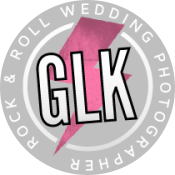
Having spent the years between 1995 and 2005 photographing hundreds of rock and roll bands with a point and shoot film camera, I completely understand that it’s the photographer that makes the photo and not the gear. When it comes to weddings, however, having a solid camera body can be a lifesaver, especially when the rules at the church call for no flash, and the place is a dark cavernous room lit only by candles. I chose to shoot Nikon because I knew I could rely on its autofocus system and the high ISO is nearly noise free. To date I haven’t shot a single ceremony with flash, and hopefully I will never have to. Anyway, here’s the latest edition of What’s In My Bag? Just in case you wanted to know.
THE CAMERA BODIES
Nikon D3s – I don’t think anyone can argue that this is the Cadillac of camera gear. When I first got into digital photography, my own wedding photographer, Kristin Reimer, had just upgraded from the D2 series to the new D3 and couldn’t stop raving about it. I already owned the D700, which was an amazing camera in its own right (borrowing a sensor directly from the D3), but I pined for the double card slots, rugged exterior and 100% viewfinder. When Nikon announced that the new D3s could shoot at 6400 ISO with almost zero noise, I decided that I had to own it. I saved every penny I earned from my first year in business and dropped every cent of it on this bad boy. Since then I have absolutely zero regrets. This camera is bomb proof, fits perfectly in my large hands, and creates 12 megapixel files that are to die for. I realize that the D3s is an extravagant camera, but as a professional, I really can’t imaging owning anything else. The insurance from the double card slots alone is worth the price of admission, and the flawless autofocus just can’t be topped.
Nikon D700 – The D700 is pretty much the reason why I switched to Nikon. I spent years waiting for Canon to release a new version of its classic 5D camera. I ignored the Nikon fanboys that were calling the D3 and D700 the greatest wedding cameras available. But when the 5DMKII finally came out, I was seriously saddened by its miserable ability to capture focus in less than stellar light. Here I was calling myself a low-light event photographer and I could barely focus on anything in a dark room. I sold everything and bought the D700. Since then I’ve been sold on the Nikon system, and the D700 as been my MVP. With the MB-D10 Multi Power Battery Pack grip attached, I use this interchangeably with the D3s and hardly know the difference. The ISO is clean up to about 3200 and the autofocus works magic in the most dreary reception situations, not to mention rock & roll concerts.
Nikon D90 – The D90 was my original backup to the D700. It was the first Nikon camera (and I’m pretty sure the first ever DSLR) with video capabilities, but I wouldn’t go around bragging about it. I can barely get the video to work. The camera, however, is perfect for our photobooth. I usually have this mounted onto an Alien Bee ring light with a moon unit. The whole kit sits on a Manfrotto video pan head attached to a rock solid tripod. At f/8 with the kit lens attached, the D90 is the perfect photobooth camera. I probably wouldn’t want to shoot a ceremony at 1600 ISO with it, but it is a more than capable backup to my backup.
Nikon F 100 – I won’t lie, I’m a giant geek for film. While I don’t have the guts to shoot an entire wedding with it (unless I was going completely traditional), I often pull this bad boy out and blow off a roll between portraits or in addition to my digital photos. I love the killer black & white shots it produces and the fact that it works with all of my modern lenses. If I ever break down and build a dark room in my basement, the F100 is going to get a ton more use.
Lomography LC-A – When I’m truly feeling inspired I break out my Lomo. This is a fancy (and 35mm) version of the classic Holga. I’m sure I’m going to get a lot of heat from purists, but this is a really expensive point-and-shoot camera that takes photos similar to the plastic cameras sold by Urban Outfitters. The good thing about the Lomo is that you aren’t going to lose tons of money on rolls of film that were destroyed by light leaks. I love the fact that this camera slows me down and makes me think before I click on the shutter. I have to make sure that I’m the proper distance from the subject in order to focus properly, and the viewfinder is so small that I have to be really careful when I compose. I would kill for the chance to shoot an entire engagement session with my Lomo.


I love your blog very informative I would love to hear of your photobooth set up few questions if you don’t mind how are your triggering the camera? Do you have someone manning it as well do you have a computer set up with like a dual monitor for the guest to see the pictures they took as well do you offer prints? Thanks for any answers you provide thanks.